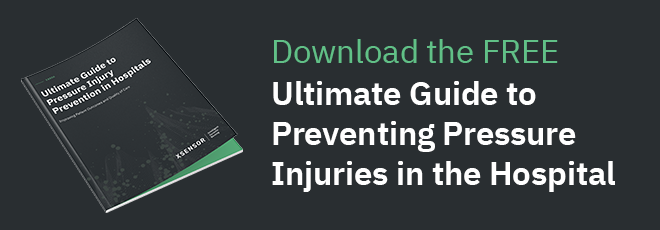The benefits of incorporating continuous skin monitoring technology to mitigate and prevent hospital-acquired pressure injuries.
Pressure injuries are a serious issue in hospital settings, impacting long term and acute care patients alike. Not only are patients at risk, but pressure injuries introduce serious financial implications for care facilities, adding even more of a burden to the healthcare system. Whether medical staff are contending with a stage one pressure injury or a stage four, efforts to manage and prevent pressure injuries are warranted.
Often, many health care institutions rely on manual, physical work to prevent sores, which means staff attention is being diverted from more critical issues, such as complications from the ongoing COVID-19 crisis. Though some technology aimed at reducing or eliminating pressure injuries currently exist, they’re often in distinct silos and have not yet been effectively combined into a useful system.
When it comes to finding a better way, it’s important to remember the earliest credo of healthcare: “Primum nil nocere”, first do no harm. At minimum, a new pressure injury management solution must not introduce any risk of harming patients. Of course, medical professionals must further evaluate solutions that improve patient outcomes and increase value to the care facility. There are greater advantages in a solution that benefits patients and improves care outcomes by alleviating the severity and incidence of pressure injuries—or avoids them altogether.
Shifting to an individualized approach to pressure injury prevention
Medical professionals know that one of the simplest ways to prevent pressure injuries is to avoid sustained pressure on high risk body areas by regularly repositioning patients. This method, while effective, is a blanketed approach that creates more workload for nurses and caregivers who have to turn each patient every two hours.
An individualized approach to care would quickly eliminate the need to turn every single patient at that frequency. Right now, staff currently lack the data, insight, or alert systems to let them know “when” a turn will prevent injury. In order for pressure injury prevention to be more successful, repositioning needs to be more accurate. Identifying which patients require less time in between turns and which need to be turned more frequently means medical staff can more efficiently prioritize their workload.
And while the term ‘individualized approach’ may sound like it requires more one-on-one attention from medical staff, an ideal solution would work continuously in the background and improve over time, thanks to artificial intelligence. With AI algorithms capturing anonymized data and continuously learning in order to make future pressure-related predictions, medical staff can increasingly conserve more of their valuable time, focus, and attention—while still preventing pressure injuries before they start.
What an ideal solution would look like
Because pressure injuries can develop quickly in long-term and acute care patients, implementing continuous monitoring technology offers a holistic, data-driven approach to patient care that boosts preventative measures.
A sensor system that measures patient body surface pressures, integrated into either a fitted mattress overlay or a dedicated mattress, will reduce staff time spent on monitoring, turning, preventing and treating pressure injuries.
At the nurses’ station
To meet the demands of a busy hospital setting, a continuous monitoring system needs the ability to be activated remotely with a dashboard available at the nursing station, so staff can see all at-risk patients at a glance. To support workload prioritization, an alert system that provides enough advance notice is necessary to ensure a patient can be repositioned on time without disrupting other tasks.
At the patient’s bedside
In the hospital room, information needs to be understood at a glance so healthcare workers can quickly determine the location of elevated pressure points and extent of patient movement. With rich visualizations generated from AI-powered joint tracking and patient positioning, nurses will be able to clearly see if the patient has been resting in the supine or prone position, or on a specific side. The patient turn clock displayed on a touchscreen monitor tracks the time since the last reposition, visually notifying the clinician that it’s time to adjust the patient’s body position.
Effectively this would require a system that consists of a sensor-enabled advanced pressure redistributing surface with integrated moisture management. Ideally, the surface would use a multi-zone design composed of pressure relieving foam to ensure patient comfort and safety, and an active microclimate layer that uses low-air loss to manage moisture.
The ease of use of the entire system like this will enable clinicians to individualize patient care and improve pressure injury management and healing. The ability to be more precise with repositioning would also benefit patients, who would not have to be disturbed as often during critical periods of rest for inconvenient movement.
Tracking to successful patient outcomes
To reduce the administrative workload in the hospital and once a patient has been discharged, an ideal continuous skin monitoring system would offer aggregated multi-patient reporting of pressure injury risk and patient turn activity in order to help staff comply with patient turn guidelines.
And with secure, HIPAA compliant data collection, storage and retrieval would be easily managed by the hospital’s informatics and IT staff.
Pressure injuries are time-consuming and costly for healthcare workers and hospitals; for long-term and acute care patients, they’re painful and potentially life-threatening. Current methods of managing pressure injuries simply aren’t enough: in the U.S., 60,000 deaths related to hospital acquired pressure injuries (HAPI) are reported every year. To improve the workloads of medical staff and by extension, patient outcomes, a continuous skin monitoring mattress system that supports an individualized approach to care is needed. As this system works continuously in the background, over time, its predictive capabilities will further help prevent pressure injuries before they begin.


